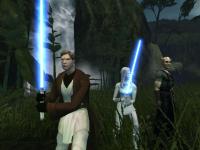| |
 Site Navigation
Site Navigation
Main
News
Forums
Games
Games Database
Top 100
Release List
Support Files
Features
Reviews
Previews
Interviews
Editorials
Diaries
Misc
Download
Gallery
Music
Screenshots
Videos
Miscellaneous
Staff Members
Privacy Statement
|
 |
|
|
Gorath
Mostly Harmless

Joined: 03 Sep 2001
Posts: 6327
Location: NRW, Germany |
Okay, is this thread officially dead or do you still want to come up with something which can be used at least in a fixed forum thread or so?
_________________
Webmaster GothicDot |
 Tue Mar 29, 2005 1:09 pm
Tue Mar 29, 2005 1:09 pm |
|
|
HiddenX
The Elder Spy

Joined: 20 Jul 2001
Posts: 749
Location: NRW / Germany |
Michael C's Category-System still works best for me - the numerical values could be a bit more "fuzzy":
VERSION 0.6
To determine if a game should apply to a certain level, all the mentioned demands must be fulfilled in that level and the levels below.
CRPG Categories: Story, Characters, NPC’s, Game-world, Manipulation, Combat.
Other interesting categories: Graphics, Sound, Game length, Difficulty, Perspective and Play-style.
Each category is divided into 6 frames from "none" to "Heavy" CRGP-elements giving a score from 0 to 5 points.
A games points from each category will be added together and then divided with 6 and will classify it's CRPG-score to the following list:
RPG-Elements Score 0 - < 1 point => "No CRPG"
RPG-Elements Score 1 - < 2 points => "CRPG ultra light"
RPG-Elements Score 2- < 3 points => “CRPG light
RPG-Elements Score 3 - < 4 points => "CRPG"
RPG-Elements Score 4 - 5 Points => "CRPG Heavy"
The RPG-element categories and their 6 scores/frames.
STORY:
No: 0 Points:
-The story is told in the beginning, and finished in the end, AND is not changeable during the game.
Ultra light: 1 point:
-A Few ”events” (NPC’s, happenings (Disasters, divine influences etc), Full movies interludes etc.) evolves the story, but still in a given path.
Light: 2 points:
-The story is developing through chapters or milestones, which still have an almost fixed path.
-A very few side stories/quests, OR noticeably different paths you can take to advance the same story, are available.
Medium: 3 points:
-The story develops as the game proceeds, meaning new information’s/events contribute for developing of the story on a frequent basis.
-Events (See above) impact on the story are considerable,
-The gamers actions have considerable impact on the development of the story.
-More than one path is possible in the ”main” story. Not necessarily more endings, just the possibility to choose between different “story” path’s of the “main story”. (Side quests not directly related to main story don’t count).
-A few side stories/quests besides the “main story” must be available.
More: 4 points:
-A few different endings is possible
-More than 2 ways to go through the story
-Lots of side stories/quests are required.
-Quests or tasks got often more than one solution!
Heavy: 5 points:
-Very open ended, with very high replay value regarding the story alone.
-Many events will contribute to many side / main story topics and respond to many different approaches from the player.
-Lots of books or other materials can give additional information’s about world for the interested player.
CHARACTERS:
No: 0 Points:
-No development other than a better weapon, armour and a few pre-distributed skill points after each chapter / milestone.
Ultra light: 1 point:
-Max 2 points to distribute on the character(s) abilities (Attributes /spells / treats / skills) each time they develop levels and a maximum of 10 upgrades(Levels) of the character(s). Learning by doing covering the same amount of development is acceptable too.
Light: 2 points:
-Max 5 points to distribute on the character(s) at least 5+ different abilities (Attributes /spells / treats / skills) each time they develop levels and at least 10+ upgrades(Levels) of the character(s). Learning by doing covering the same amount of development is acceptable too.
-A minimum of social development / regards in the game-world societies is necessary) (Wiping out a society/guild is not counting)
Medium: 3 points:
-More than 5+ points to distribute on the character(s) at least 10+ different abilities (Attributes /spells / treats / skills) each time they develop levels and at least 15+ upgrades(Levels) of the character(s). Learning by doing covering the same amount of development is acceptable too.
-The characters can have considerable social impact on more than one society / guild. (Wiping out a society/guild is not counting)
More : 4 points:
-Now a party of at least 3 fully controlled characters should be possible,
-The choice from different professions / races should give a combination of at least 10 possible different characters (Note: Different mug-shots don’t count).
-Considerable social impact on more than 2 societies / guilds is possible. (Wiping out a society/guild is not counting)
Heavy: 5 points:
-More than 10+ points to distribute on the character(s) at least 15+abilities (Attributes /spells / treats / skills) each time they develop levels and at least 20+ upgrades(Levels) of the character(s). Learning by doing covering the same amount of development is acceptable too.
-+15 different races/ professions to choose from.
-Plenty of societies/guilds which the characters have a social impact on. (Wiping out a society/guild is not counting)
NPC's:
No: 0 points:
-Few NPC's most only merchants.
-Pre-determined dialogues.
Ultra light: 1 point:
-The dialogues now have a few options, but it still contribute to the same story, AND each choice is reversible in consequence.
Light: 2 points:
-NPC's are presented in small societies, AND some of them can make a difference in further development of the game.
Medium: 3 points:
-NPC's acts truly as a part of a bigger community.
-NPC's in each society are much aware about social status also toward your characters.
-More than one society with NPC's are present in the world.
More: 4 points:
-There are fleshed out dialogue trees,
-Choices is most final and irreversible.
-NPC’s have considerable impact on the amount of Main / side- stories.
Heavy: 5 points:
-NPC's are aware of the continuously developing situation in the game-world, AND react clearly to the gamers actions and deeds.
-More than 2 bigger societies of NPC's must be available.
-Reputation, skills, alignment, attitude etc. have considerable impact on the NPC reaction.
GAMEWORLD:
No: 0 points:
-The task to get from A to B has no or few options to go away from a fixed physical path.
-The game-world only inhabits monsters and a few merchants.
-The world is without (none monster) societies.
Ultra light: 1 point:
-Still a strict physical path, but with a few small societies on your way.
Light: 2 points:
-A few areas are optional on your path each chapter / milestone.
-Societies will give some quest / story material.
Medium: 3 points:
-There are at least several physical path's to choose between, AND more will open up as the game proceeds.
-Societies must give the feeling of a live community, with their own daily business, AND not just a few NPC's waiting for the hero's to come along and pass on a few quests.
-The size of the game-world must be considerable.
More: 4 points:
-Societies must be very different and have strong relation to the game-world and each other.
-We are no longer talking about a few path's when exploring the world.
-The appearance of monsters and societies must make common sense.
Heavy: 5 points:
-The world is totally open for extreme freedom to explore, AND it's your own task to decide if your character(s) are good enough to take on the different part of the world.
-The diversity of the game-world environment must be significant.
-Day & night cycles, and different weather conditions and /or different seasons.
MANIPULTION:
No: 0 points:
-Almost no action possible besides walk/run and combat, except maybe a very few items.
-Game-world itself is very static.
Ultra light: 1 points:
-Very few limited interactions besides walking and combat.
- A few chest barrels is scattered through the game.
Light: 2 points:
-There are a few weapons, armours, items in the game.
-Traps, levers, keys and alike is available in it's simple presence.
Medium: 3 points:
-The game-world have a considerable amount of weapons, armours, items, skills, spells in significant variations.
-The things to do will quickly fill up more than one page in your journal, AND keep it that way for most of the game.
-Custom items must be available. (Custom items are items that can’t directly be found in the game-world, the player needs to either combine more items or process an item with (Fire, acid, poison, magic, tool-masters etc (repairing items don’t count)). It’s not limited to weapons and armour only)
More: 4 points:
-You can see /influence changes in the environment, OR use it either to create/ manipulate things or get strategic possibilities in combat. (Summarised: Game-world environment itself offers several interactivity possibilities: (Chopping trees, make fire, diving in water, hide behind objects, move/destroy/manipulate objects, etc.)
– A few different ways of making custom items must be available. (See above).
Heavy: 5 points:
- Many different ways of making custom items must be available. (See above).
-Alchemist, spell-casters, smiths, herbalist and other item collectors are in heaven due to the tons of items for manipulation.
-Game-world environment itself offers many interactivity possibilities: (Chopping trees, make fire, diving in water, hide behind objects, move/destroy/manipulate objects, etc.)
COMBAT:
No: 0 points:
-You put your character(s) into position and they solve combat on their own, or the combat result is only affected by your skills on the keyboard.
Ultra light: 1 point:
-Real-time combat only without any pause options.
-Options are limited to the choice of the opponent to attack.
Light: 2 points:
-Character skills and/or players strategic abilities have a noticeable more impact on the outcome of the battles too.
Medium: 3 points:
-Players can more decide the pace of the battle,
-Strategic positions of the party is more vital, and the options for each character is more plentiful.
-At this point it's also important that monsters offers some diversity not only in numbers, but also in strategies necessary to win.
-Monsters AI are more than attacking the closest enemy!
- There must be more issues for your characters during combat, than loosing or giving hit-points. Ex. Poisoning, paralyse, curse etc.
More: 4 points:
-Their must be alternatives to swing your sword and cast a spell during combat Ex. Skills, traps, spells, treats, or items to use in battles.
-Different strategies are necessary for survival.
Heavy: 5 points:
-Each characters can be controlled individual down to the smallest detail and in any pace wanted.
-The monsters must offer a lot of difference both in numbers, abilities, battle environment, which must offer quite a diversity in battle approaches.
- Monsters AI are considerable.
OTHER NON-RPG RELATED INTERESTING CATEGORIES:
GRAPHICS:
An “Year” of evaluation should follow the graphics score!
We try not to express how beautiful the graphics is (It's difficult to separate entirely), just how many specific graphic technology elements it contains (Like shadows, lightning etc), and it's standard compared to others at the time of the review!
0 points: Text only.
1 point: Static pictures, and/ or low 2D resolution in relation to other games in the year of evaluation.
2 points: Higher 2D resolution in relation to other games in the year of evaluation.
3 points: Mediocre 3D or 2D with up to date standard compared to others in relation to other games in the year of evaluation.
4 points: Fully 3D with up to date standard compared to others in relation to other games in the year of evaluation.
5 points: Fully 3D. Absolute among the best in it's category, with a few ground breaking content compared to others at the time it is reviewed.
SOUND:
This determines the amount and the degree of acoustic technologies in the sound, not directly the quality or realism of the sound, and not how many different sound boards it covers.
0 Points: No sound.
1 point: Mono sound.
2 points: Very sparse and basic Stereo sound
3 points: Plentiful Stereo sound
4 points: Support of more than 2 speakers, and considerable environmental sounds.
5 points: Fully real surround sound support (At least 5.1), with ultra real 3D feeling
LENGTH:
An average length is used for calculation, a second score in “( )” for maximum hours searching under every stone and solving every quest could be mentioned if it brings the game into another score-area.
0 points: Under 8 hours.
1 point: 8 - 20 hours.
2 points: 20- 50 hours.
3 points: 50- 80 hours.
4 points: 80 - 150 hours.
5 points: over 150 hours.
DIFFICULTY:
0 points: No brain teasers at all, only walk /run and hack 'n slash
1 point: Easy brain teasers that don't slow the game pace down considerable.
2 points: Some problems (Riddles, events, combat, NPC's etc) can make you stop for a short while until you find the relative easy solution!
3 points: Not all problems are obvious in solution, but there are more possibilities to get help. The amount of problems must also be considerable.
4 points: Some problems can't be solved without help/things from other places or without some in vain tries first!
5 points: The game is loaded with more or less hard problems, and many problems can only be solved by extensive brain use!
PERSPECTIVE:
A Non-score category:
TXT: No perspective (e.g. no graphics), text games.
FIX: Fixed viewpoint (Not changeable).
FLEX: Flexible distance/orientation . The viewpoint distance can be changed and/or the screen can be rotated.
ISO: Isometric view ( Any angle between vertical top-down and 1.st person view, but still seen from above the party/ characters.
SHOULDER: The close overhead / shoulder view, where the gamers viewpoint follow the character(s) heading, with a look just above the head/shoulders of your character(s), and the character(s) can be seen in the button of the picture.
FP: The 1.st person view where gamers viewpoint is the same as looking out of the eyes of the character(s)
BIRD: From the sky the players has a vertical down view point on the game-world.
SIDE: View points like Platform games or the elder Kings/Space quest games
EX:
Might & Magic VII: Perspective: FP
Diablo 2: Perspective: ISO-FIX
Summoner: Perspective: SHOULDER/ISO-FLEX
PLAYSTYLE:
A non-score category.
SP: Single player
MP: Multiplayer
OP: Online play possible
MMO: Massive multiplayer online!
Co: Co-operative multiplayer possibility
PvP: Player versus player mode in multiplayer mode.
P: Parties possible.
S: Single character game
EX:
Might & Magic VII: Style: SP-P
Diablo 2: Perspective: Style:SP-S, MP-Co/PvP, OP-Co/PvP
Summoner: Perspective: Style:SP-P,MP?
A conclusion on a game could look like this:
Might & Magic VII
RPG Factors: Story: 3, Character: 5, NPC:3, World: 5, Manipulation:4, Combat: 4.
RPG Score:= 4.0 => "RPG heavy"
Other Factors: Graphics:2 (1998?), Sound:3, Length:3(4), Difficulty:4, Perspective: FP, Style:SP-P.
_________________
=Member of The Nonflamers' Guild= |
 Tue Mar 29, 2005 2:33 pm
Tue Mar 29, 2005 2:33 pm |
|
|
|
Goto page Previous 1, 2, 3 ... 14, 15, 16
All times are GMT. The time now is Mon Apr 08, 2019 6:42 pm
|
|
|
|
|
|
|





